|
CONTENTS
NBA Footballers
Ineptitude Personified
Attendance Problems
Chris Paul
Famous Play
Who Needs Two Hands?
Fabulous Walk-on
First Israeli in NBA
OSU Not Big Enough for Both
Seattle's Comin' Back
Basketball Did You Know? – I
Basketball Did You Know? – II
Basketball Did You Know? – IV
Basketball Did You Know? – V
Basketball
Magazine
Golden Rankings Home
Back to Top |
Basketball:
Did You Know? – III
|
NBA Footballers
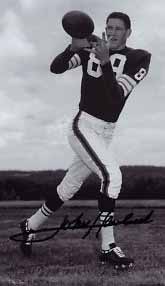
John Havlicek
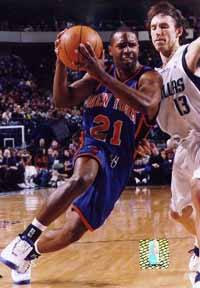
Charlie Ward
|
Some NBA players also competed in other sports in college and even in the pros. Here's the story of two of them.
- John Havlicek starred on the hardwood for Ohio State from 1960-2. At Bridgeport (OH) High School, he had made All-State not only in basketball but also in football (as a QB), and baseball. However, at OSU he played only basketball after his freshman year when he competed on the diamond, hitting over .400. The 6'5" 210 lb "Hondo" was drafted by the Boston Celtics in the first round. But imagine everyone's surprise when the Cleveland Browns also took him in the seventh round of the NFL draft that same year (1962). Havlicek actually went to training camp with what would turn out to be Paul Brown's last Cleveland squad. After playing WR and DB in several exhibition games, Havlicek was cut by the Browns. Cleveland's loss was Boston's gain as Havlicek forged a Hall of Fame career with the Celtics until his retirement in 1978. He made the All-Star team 13 times. In 1997, he was selected as one of the 50 Greatest Players in the first 50 years of the NBA. His jersey has been retired by both Ohio State and the Celtics.
- Charlie Ward was also drafted by two pro leagues, but neither one of them was the sport for which he gained fame in college! He won the 1993 Heisman Trophy and the Davey O'Brien Award after QBing Florida State to the national championship. He had also played PG for four years for FSU. So he announced before the NFL Draft that, if he was not taken in the first round, he would sign with the NBA. With concerns about Charlie's size and arm strength, no NFL team drafted him in any round. So he signed with the New York Knicks, who took him in the first round. Charlie played in the NBA until 2005. He was a member of the Knick team that lost to San Antonio in the 1999 Finals. But our story of Charlie's athletic ability doesn't end here. He was also drafted not once but twice by MLB as a P (Brewers 1993, Yankees 1994) even though he hadn't played baseball since high school. He was also an outstanding tennis player, shining at the Arthur Ashe Amateur Tennis Tournament in 1994.
|
|
Donald Sterling has owned the Los Angeles Clippers since 1981. When he bought them, they were the San Diego Clippers but after three seasons, he moved the team to LA. During the 29 seasons he has owned the franchise, the Clippers have:
- Fashioned a 701-1,317 record (.347).
- Finished with a .500 or better record only three times.
- Had a winning percentage of less than .300 ten times (including 19-63 for .232 in 2008-9).
- Lost 60 games in a season seven times.
- Made the playoffs only four times (1991 and 1992 under Larry Brown, 1997 under Bill Fitch, and 2006 under Mike Dunleavy).
- Won only one playoff series – over the Denver Nuggets (4-1) in 2006 after which they lost to the Phoenix Suns in seven games.
|
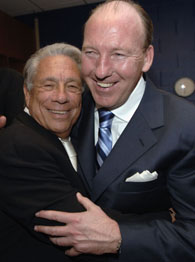
Donald Sterling and Mike Dunleavy
|
Sterling, born Donald Tokowitz to Russian Jewish immigrants, made his fortune as a personal injury and divorce attorney who invested his earnings in real estate.
- He first entered the NBA as a minority partner for Jerry Buss when the latter bought the Lakers in 1979.
- It was Buss who suggested Sterling buy the ailing Clippers two years later.
- When Sterling moved the team to LA, the NBA fined him $25 million for doing so against league policy. When Sterling contersued for $100 million, the league cut his penalty to $6 million and allowed him to pay it out of his share of expansion fees.
- Sterling is the poster child for sports owners who, thanks to revenue sharing, milk profits out of their franchises without spending the money necessary to put a quality product on the court.
Read the article referenced below to find out more about Sterling's life, including his personal legal battles.
Reference: "Uncontested: The Life of Donald Sterling," by Peter Keating, ESPN The Magazine, June 1, 2009
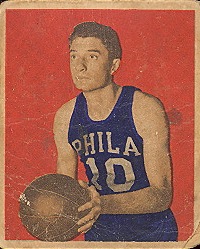
Joe Fulks, early star of the BAA
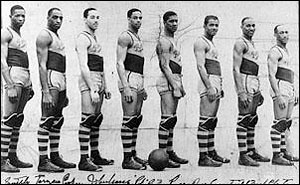
Harlem Renaissance
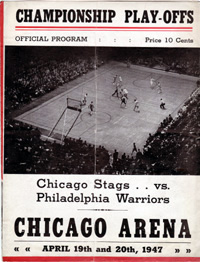
|
The first season of what is now the NBA is considered to be 1946-7. Ten teams competed in two divisions, East and West, in the Basketball Association of America (BAA). However, attendance was disappointing, even in New York and Philadelphia. So the league and team front offices came up with ideas to put more fans in the seats, including experimenting with longer games.
- The previous summer, the Executive Committee of the new league decided on 12-minute quarters. The idea was to give customers more than they would get at a college game (10-minute quarters) and "the same return for their entertainment dollar as they would get from a Broadway play, a movie, or a baseball game."
- However, with attendance lagging midway through the initial season, Arthur Wirtz, owner of the Chicago Stags, proposed 60-minute games. Commissioner Maurice Podoloff polled the owners and got their consent for a trial of the longer games by interested teams. Podoloff himself was skeptical, fearing a demand from the players and referees for more money for the longer games. Three one-hour games were played and "proved to be prolonged exercises in tedium." Podoloff attended the first one, between the Stags and the Detroit Falcons in Chicago and concluded that "the game would have been boring even if it had lasted only 40 minutes." When attendance at the three longer games was below average, the experiment was dropped.
- The 48-minute games had already posed a problem for clock operators. The arenas were set up for hockey with its 20-minute periods, and 12-minute clocks were expensive to have custom made. So creative methods were used to time BAA games. Podoloff suggested every team use the Madison Square Garden approach.
The first two minutes of the first quarter were taken care of by stop watch, the [scoreboard] clock being started at the beginning of the third minute in each quarter, so that when the clock showed ten minutes, the first quarter was over, and when twenty minutes was showing, the second quarter was over. The same performance, of course, was repeated during the second half of the game.
- Another stimulus that had some positive effect was scheduling preliminary games matching teams of local interest. If teams from boys' clubs, city leagues, or YMCA competition played, their families would attend. Basketball teams featuring pro football players from the New York Giants and Philadelphia Eagles added to the attendance in those two cities. The most successful preliminary game pitted the Philadelphia Sphas and the Harlem Renaissance, "a colored team," before a Washington Capitols-Philadelphia Warriors contest in The City of Brotherly Love. The gate receipts that night totaled $10,000, which was double what the Warriors took in the previous week against the New York Knicks. Surprisingly, only about $400 of the take came from negro attendance, which was carefully monitored.
- The league staggered to the finish. However, only eight teams competed in 1947-8. Toronto, Cleveland, Detroit, and Pittsburgh folded, and only Baltimore was added.
|
|
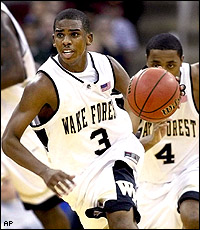
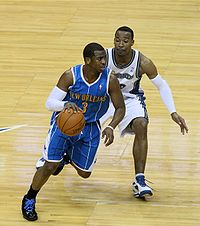
|
Some facts about Chris Paul of the New Orleans Hornets.
- Chris grew up in Winston-Salem NC in a middle-class family. His parents stressed grades and character. Tattoos and piercings were forbidden. "My mom always said she'd be the only one putting an earring on in the morning," says Paul.
- As a teenager, he worked at his grandfather's service station, pumping gas and changing tires
- Chris didn't make the varsity team until his junior year. He made up for lost time, becoming North Carolina Player of the Year and a McDonald's All-American as a senior in 2003.
- Although he didn't win a high school state championship, Chris led his AAU team to the 2002 national championship.
- He stayed in Winston-Salem to play for Wake Forest for two years. The Demon Deacons made the NCAA tournament both seasons, reaching the Sweet Sixteen once.
- He made ACC Newcomer of the Year and was named National Freshman of the Year by several publications. As a sophomore, he made First Team All-American and the All-ACC Defensive Team.
- The Hornets selected Chris with the fourth overall pick in the 2005 NBA Draft. GM Allan Bristow actually wanted Deron Williams of Illinois but the Jazz took Deron at #3.
- Playing in Oklahoma City after Katrina, Paul won Rookie of the Year honors over Williams. His second season, the Hornets again played the vast majority of their games in Oklahoma City. For 2007-8, playing back in New Orleans, the team came within one game of reaching the Western Finals.
Chris has experienced tragedy in his young life but uses it as motivation to help others.
- The day he signed with Wake Forest, his grandfather, whom he called "my best friend," was killed by five teens in his home during a robbery. Chris says, "I feel no hatred towards these boys. What I hate is that they are wasting their lives in prison."
- When he turned pro, Paul created the CP3 Foundation, which gives away $500,000 a year for charitable works. The first time he visited New Orleans after the draft, he thought "it didn't look like the United States." He quickly got to work in his adopted home, feeding 200 needy families on Thanksgiving Day and taking 100 kids on a Christmas toy shopping spree.
- NBA Commissioner David Stern says, "New Orleans was in such need. Turned out you had the right player in the right place."
- Paul's 6' size led to a humorous incident on one of his first visits to the Crescent City two months before Katrina. He and another player went to Best Buy, where team members received a discount. A woman at the checkout counter refused to give it to him. "You don't play for the Hornets; you're too small," she said.
|
Reference: "Helping Hands," Monte Burke, Forbes Magazine, June 22, 2009
|
One of the most famous plays in basketball history occurred in the 1992 NCAA East Region final.
- Duke trailed Kentucky 103-102 with 2.1 seconds left in OT. The Blue Devils had to put the ball in play from under their own basket.
- After a timeout, Grant Hill threw an 80-foot pass to the other foul line to Christian Laettner, who turned and sank a 17-foot jumper as time expired.
Watch on YouTube.
Laettner revealed many years later that the play hadn't worked well on a previous try.
- "I remember that we tried to run it one time against Wake Forest and Grant's pass was like a curveball. It took me out of bounds, and I wasn't able to shoot it."
- "We went back to the drawing board and practiced it a few more times when, lo and behold, we needed to use it two or three weeks later in the Kentucky game."
- "I had time to stay calm and be relaxed and take a nice, easy shot at the bucket. I had time to not rush, and that is very important."
- "Then the last thing I remember thinking is that I had to catch the ball ... because a lot of the time on a play like that, the defense knocks or tips the ball away."
Rick Pitino was criticized for the D he set up on the play.
- Why didn't he put a defender on Hill to hamper his pass? Pitino explained that his two tallest veteran players, Jamal Mashburn and Gimel Martinez, both 6' 8", had fouled out. Hill later recalled that, when he went to the baseline and saw that his pass would not be obstructed, he breathed a sigh of relief.
- Why didn't KU contest Laettner's reception? This is a bogus charge. If you watch the video link above, you will see that 6'7" John Pelfrey did jump for the ball but the taller Laettner grabbed it.
Reference: "I Remember ... Christian Laettner," Sporting News March 16, 2009
|
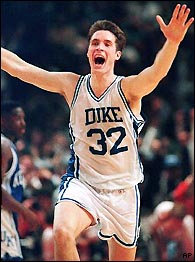
Christian Laettner
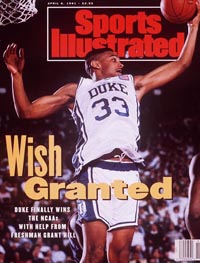
Grant Hill
|
|
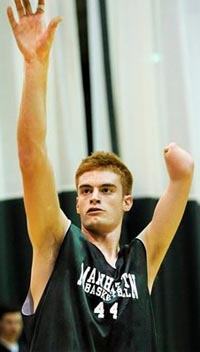
Kevin Laue
|
6'11" Manhattan College freshman Kevin Laue needs only one hand to play college basketball. He was born without a left hand because the umbilical cord was wrapped twice around his neck in the womb. Fortunately, his left arm had become wedged between the cord and his throat which kept him from choking but also stunted the growth of that arm.
Laue is thought to be the first one-armed player to earn a Division I basketball scholarship.
Despite being steered toward soccer as a small boy, Kevin gravitated to basketball. He pursued rebounds and blocked shots aggressively as he grew and grew. He learned to catch the ball by pinning it with his left arm and right hand.
Watch a CBS Early Show feature on Kevin.
Reference: "A Tough One-hander," Sports Illustrated October 26, 2009
|
|
Mississippi State Coach Rick Stansbury had a question for his star C Jarvis Varnado.
Would Jarvis give up his scholarship and walk-on to the Bulldog team for his senior year?
State had successfully recruited 6'10" Renardo Sidney but had no scholarship to offer him. Most coaches would have pulled a scholarship from a marginal player, but Stansbury had another idea. If Jarvis chose to remove his name from the 2009 NBA draft, would he be willing to pay to play his senior year? Jarvis said yes and did decide to forego the draft. In his words:
My teammates were shocked. When I told them I was going to walk on, they didn't believe me.
Jarvis doesn't have a rich family. His father is a high school basketball coach in West Point MS while his mother works in a factory. So he took out a student loan for the $5,151 tuition, planning to pay it back with his NBA signing bonus.
It's easy to see why Stansbury wanted Varnado back on the court.
- The 6'9" 230 lb C, who has a 7'4" wingspan, has led the nation in blocked shots each of the last two seasons.
- Entering the 2009-10 season, he was only 19 blocks away from breaking Shaquille O'Neal's SEC career record of 412 (set in only three seasons) and 142 away from the NCAA mark of Wojciech Mydra of Louisiana Monroe (1998-2002).
- Last year, as a junior, Varnado averaged 12.9 points and 8.8 rebounds per game.
Reference: "Menace in the Middle," Sports Illustrated, November 23, 2009
|
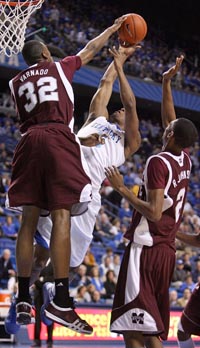
Jarvis Varnado
|
|
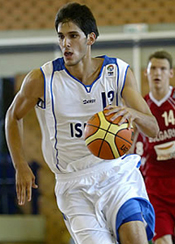
Omri Casspi of Maccabi Tel Aviv
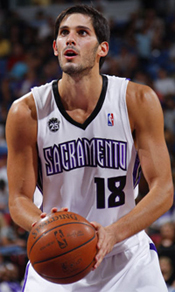
Casspi the King
|
"Welcome, the King of Israel"
That's the headline on a story in the 12/21/09 Sports Illustrated about the first Israeli to play in the NBA.
- His name is Omri Casspi and he plays for the Sacramento Kings. (Hence the pun in the SI headline.)
- The 21-year-old Casspi hails from Yavne, which is a suburb of Tel-Aviv.
- As a boy, Omri arose at 4 am to watch Michael Jordan on TV. At 17 he joined Maccabi Tel Aviv, Israel's best team.
- Drafted by the Army at 18, Casspi was granted an exemption as an "outstanding athlete" so that he could continue to play for Maccabi. He went through basic training but had to report to the base just twice a week.
- Omri (6'9" 225 lb) caught the attention of Jason Levien, a Jewish agent who dreamed of bringing an Israeli player to the NBA. Levien's plan took a leap forward when Sacramento hired him as assistant GM in November 2008. It helped that Kings scouts had also noted Casspi's potential.
- The Kings drafted Omri with the 23rd pick of the first round. The NBA's web site summarized him as: "Skilled forward who exhibits toughness on the boards."
- Casspi wears the number 18, with a special shape on the 8, because it is the Jewish symbol for life. He quickly gained a reputation for hustle as exemplified by floor burns and busted lips.
Rabbi Reuven Taff of the Mosaic Law Congregation of Sacramento makes sure that several members of the congregation attend every Kings home game. They wave two Israeli flags Omri's father gave the Rabbi when he visited the family last summer in Yavne.
As this is written, Casspi is averaging 24.5 minutes, 11.5 points, and 3.8 rebounds per game for Sacramento.
|
|
OSU Not Big Enough for Both
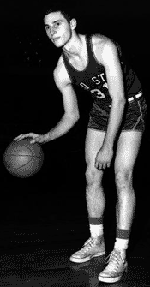
Bobby Knight, Ohio State
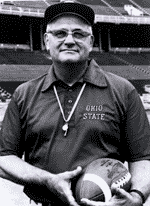
Woody Hayes
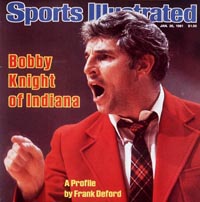
|
Bobby Knight, long-time coach of Indiana, was a reserve F on Ohio State's 1960 NCAA champions.
- Bobby admired his basketball coach, Fred Taylor.
- He also idolized the football coach of the Buckeyes, Woody Hayes, since Bobby was a kid growing up in Orrville OH.
After graduation, Knight began his coaching career.
- After a stint in the Army, Bobby became assistant coach at West Point in 1963.
- Two years later, he was named the head coach of the Cadets at the young age of 24.
- He won 102 games and lost 50 in six seasons at the Academy. The team went to the NIT four times.
- One of his players was future Duke Hall of Fame coach, Mike Krzyzewski.
Bobby moved to a bigger stage in 1971 when Indiana hired him.
- Knight quickly established himself as one of the top coaches in America as the Hoosiers reached the Final Four in 1973 and the regional finals in 1975.
- The '75-76 Hoosiers went 32-0 and won the NCAA Championship.
Meanwhile, back in Columbus, OSU basketball had fallen on hard times.
- Taylor resigned in the spring of '76 after a 6-20 season.
- At first, the Buckeyes went to Knight for advice about whom they should hire. An associate AD and the faculty athletic representative met with him in Lousville for almost seven hours.
- When the faculty rep finally asked Knight if he was interested in the job, Bob replied that he had just coached an undefeated season and had an outstanding recruiting class on tap. But he could never turn down his alma mater.
- OSU AD Ed Weaver received the report from his two emissaries but dragged his feet.
- Ohio State president Harold Enarson didn't believe he could handle two volatile coaches, Hayes and Knight.
- Woody tried to persuade his friend and fellow military history buff to come to Columbus, but Bobby had already surmised that the university administration wasn't interested in hiring him. So he withdrew from the search.
- In September, Knight sent Hayes a letter.
The relationship I have had with you is one of the most enjoyable that I have had in athletics, and there is no one I respect more than you. I am sorry that things did not work out last spring and wish they would have involved you in the situation earlier. I greatly appreciate your thoughtfulness and consideration at the time.
Bobby probably didn't realize at the time that it was actually Hayes' imposing presence on the Columbus campus that deterred the OSU president from hiring Knight.
Reference: War As They Knew It: Woody Hayes, Bo Schembechler, and America in a Time of Unrest, Michael Rosenberg
|
|
Seattle University, a private college run by the Jesuits, is famous in basketball circles as the alma mater of Elgin Baylor, one of the all-time greats of the sport.
- Seattle hoops flourished in the 1950s when Johnny and Eddie O'Brien led the Chieftains, as they were known then, to a victory over the world famous Harlem Globetrotters.
- In 1952, Eddie O'Brien became the first player to score 1,000 points in a season.
- Six years later, Baylor led Seattle to the Final Four in Louisville, where they defeated #1-ranked Kansas State 73-51. However, with Elgin limited by a broken rib, Seattle fell to Kentucky in the finals, 84-72.
- Because it pioneered integration of teams, Seattle was known as "the United Nations of college basketball."
Seattle's success on the hardware continued in the 1960s.
- No other school contributed as many players to the NBA in that era, men like Eddie Miles, John Tresvant, Rod Derline, Clint Richardson, and Tom Workman.
- The 1966 Seattle team handed Texas Western its only defeat in a season that culminated in the Miners' ground-breaking victory over Kentucky in the finals.
After spending nearly 30 years as an independent, Seattle joined the West Coast Conference in 1971.
- While Seattle continued to compete athletically, the 70s were a trying time for the Great Northwest. The "Boeing Bust" triggered a depression in the area that led to the loss of jobs and a mass exodus from the region.
- Faced with economic challenges, the need to comply with new NCAA guidelines concerning women's sports, and competition from the Seattle Supersonics as well as the Seahawks, the school administration decided to drop down to the NAIA.
- After 20 years at that level, the university moved most of its athletic programs to NCAA Division III in 2002 and then to Division II the following year.
- Currently (01/2010) Seattle is in the third year of a five-year transition back to Division I. The Redhawks won't be eligible to play in the NCAA basketball tournament until 2013.
The 2009-10 Redhawk basketball team features a player who has NBA scouts buzzing. How did such a potential superstar fall into the lap of a program just returning to top division competition?
- Charles Garcia Jr. is a 6'10" 230 pounder who can literally play any position on the court, including PG.
- As a 6'7" senior at Dorsey High in Los Angeles, Garcia wasn't heavily recruited because of concern about his grades.
- He played briefly at Sacramento State and then at Diabo Valley College.
- He played at Riverside (CA) Community College for a season and a half, where he was recruited by Cameron Dollar, an assistant coach at Washington at the time.
- Even after attending Yuba College in Northern California for a semester to focus on academics, Garcia couldn't meet Washington's standards for admission.
All was not lost for Garcia in terms of playing Division I basketball.
- Dollar was hired as the head basketball coach at Seattle for the 2009-10 season.
- He suggested that Garcia apply to Seattle, which accepted him. He was classified as a junior in eligibility, meaning he could play for two years if he kept his grades up.
- Even before fall practice began, Dollar heard reports from the other players about Garcia's talents. He was bringing the ball up the court like a PG in addition to rebounding, scoring, and defending in the paint.
- Through 20 games, Garcia averages 27.6 pts and 9.1 rebounds.
- The scouting website draftexpress.com projects Garcia as the 24th pick in the 2010 NBA draft should he decide to forego his senior season. "You don't often see 6'10" run as well or handle the ball as well," says one scout.
|
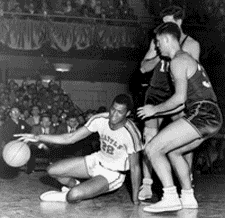
Elgin Baylor

The O'Brien brothers, who also played major league baseball
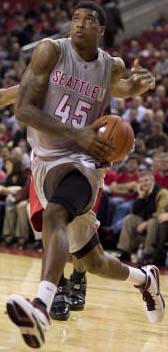
Charles Garcia
|
Reference: "Seattle's Secret," Kelli Anderson, Sports Illustrated, 01/11/2010
|
|


















